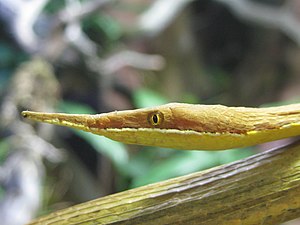Leaf-nosed snakes
| Leaf-nosed snakes | ||||||||||||
|---|---|---|---|---|---|---|---|---|---|---|---|---|

Langaha madagascariensis, male |
||||||||||||
| Systematics | ||||||||||||
|
||||||||||||
| Scientific name | ||||||||||||
| Langaha | ||||||||||||
| Bruguière , 1784 |
The leaf- nosed snakes ( Langaha ) are a genus of snake-like snakes from the Lamprophiidae family with currently three known species, whose range is limited to the island state of Madagascar . They are very slender snakes with a body length of up to 1.20 meters. As an anatomical peculiarity, the animals have a conspicuous nose attachment made of elongated scales, the function of which is still unclear today.
features
The leaf-nosed snakes reach body lengths of up to 1.20 meters and are very slim in shape. The females are evenly colored brown and have darker spots or bars on the back, the males have a red-brown upper side and a yellow belly side, which are separated from each other by a clear white line.
The head is clearly separated from the rest of the body. Both sexes have a conspicuous nose piece made of elongated scales, which in the female widened like a leaf and in the male is pointed like a spear tip. The function of this nasal attachment is unclear, the individual scales can be splayed off. In contrast to Langaha madagascariensis, Langaha alluaudi and Langaha pseudoalluaudi also have a horn-like sculpture above the eyes.
The eyes are medium-sized and have vertical pupils . Like most Australian vipers, they have ophistoglyph fangs in the back of the upper jaw, with smaller retaining teeth in front of them.
distribution and habitat
The range of the leaf-nosed snakes is limited to Madagascar . The most common species, Langaha madagascariensis , can be found almost all over the island, although it is assumed that the distribution is highly dispersed. It has not yet been found in the center of the island or in some north or south-east areas. Most commonly it is in the northern area, as Terra typica is Nosy Be specified.
As a habitat, dry and rainforests with herbaceous undergrowth and extensive areas of ferns are preferred, but snakes can also be found in almost all other biotopes .
Way of life
The leaf-nosed snakes are primarily crepuscular and nocturnal and live mainly on the ground or in branches close to the ground. They are ambulance hunters and wait for their potential victims in an almost motionless posture, in which they can be mistaken for branches very quickly due to their shape and color. Their diet consists mainly of frogs , chameleons and other lizards or small birds.
The animals lay eggs ( oviparous ) and the development of the juvenile snakes only begins when they lay eggs. Reproduction details are not known, egg-bearing females were mainly found in the months of November to February, while young snakes appear from March to April.
Systematics
So far, three species of the leaf-nosed snake genus have been described:
- Langaha madagascariensis Bonaterre, 1790
- Langaha alluaudi Mocquard, 1901
- Langaha pseudoalluaudi Domergue, 1988
The latter is only known from two specimens and differs from Langaha alluaudi only in the different design of the scalp and the non-overlapping distribution area.
Threat and protection
Like most Malagasy wild animals, the leaf-nosed snakes are mainly threatened by the decline in their habitat. Specific information on the degree of endangerment of the three species is not given, and there is no classification in the Red List of endangered species . Due to their eye-catching head shape and nose attachment, the animals are popular as terrarium animals and are caught and exported accordingly. There are no trade restrictions for any of the species, an application for inclusion in Appendix II of the CITES agreement from 2004 was not accepted.
literature
- Friedrich-Wilhelm Henkel, Wolfgang Schmidt (ed.): Amphibians and reptiles of Madagascar, the Mascarene, Seychelles and Comoros. Verlag Eugen Ulmer, 1995; ISBN 3-8001-7323-9
- Thirteenth meeting of the Conference of the Parties of the CITES: Proposal for amendment of Appendices I and II: Inclusion of Langaha spp. in Appendix II, 2004 ( full text, pdf )
- Kenneth L. Krysko: Reproduction in the Madagascar leaf-nosed snake, Langaha madagascariensis (Serpentes: Colubridae: Pseudoxyrhophiinae). African journal of Herpetology 52 (1), 2003; Pages 61-68. ( Full text, pdf )
